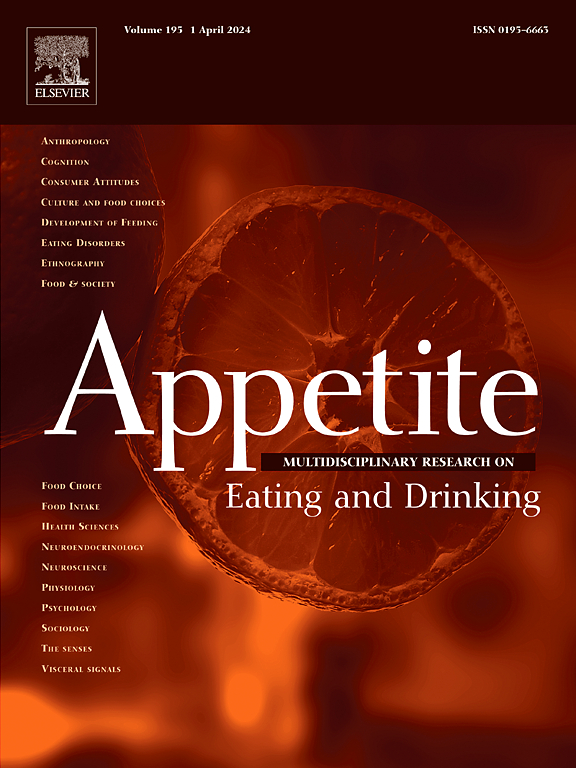重度抑郁症患者血浆谷氨酸与食物成瘾的关系。
IF 3.8
2区 医学
Q1 BEHAVIORAL SCIENCES
引用次数: 0
摘要
背景:食物成瘾(FA)在重度抑郁症(MDD)患者中更为普遍,并可能导致重度抑郁症患者肥胖的风险增加。外周谷氨酸是一种在血液和组织中发现的氨基酸,与精神健康症状、物质使用和肥胖有关。它与有问题的饮食有关,但它与FA的关系一直没有得到充分的研究。本研究调查了患有和不患有重度抑郁症的个体中谷氨酸和FA之间的关系。方法:采用耶鲁食物成瘾量表2.0 (YFAS)对61例重度抑郁症患者和60例对照组进行分类。在诊所访问中,参与者接受了诊断性访谈,人体测量评估(如BMI,血压,腰围),血液采样,并完成了心理问卷。ELISA试剂盒检测血浆谷氨酸。方差分析和相关性评估组间差异和变量关系。结果:与3%的对照组相比,41%的MDD参与者存在FA。重度抑郁症患者的血浆谷氨酸水平高于对照组。谷氨酸水平与FA严重程度、情绪和外部饮食、压力和抑郁症状呈正相关。亚组分析显示,与其他组相比,重度抑郁症和FA患者的谷氨酸水平最高。结论:这项研究提供了新的证据,证明FA症状与外周谷氨酸升高有关,强化了谷氨酸、饮食失调和抑郁之间的联系。这些发现强调需要进一步研究MDD和FA共病的谷氨酸能机制,以提供更有针对性和有效的治疗方法。本文章由计算机程序翻译,如有差异,请以英文原文为准。
The association of plasma glutamate with food addiction in individuals with major depressive disorder
Background
Food addiction (FA) is more prevalent in individuals with major depressive disorder (MDD) and may contribute to the increased risk of obesity in MDD. Peripheral glutamate, an amino acid found in the blood and tissues, has been linked to mental health symptoms, substance use and obesity. It is implicated in problematic eating however its relationship to FA has been underexpored. This study investigated associations between glutamate and FA in individuals with and without MDD.
Methods
Sixty-one individuals with MDD and sixty controls were recruited and sub-categorised based on criteria of the Yale Food Addiction Scale 2.0 (YFAS). At a clinic visit, participants underwent a diagnostic interview, anthropometric assessments (e.g., BMI, blood pressure, waist circumference), blood sampling, and completed psychological questionnaires. Plasma glutamate was analysed via ELISA kits. ANOVAs and correlations assessed between-group differences and variable relationships.
Results
FA was present in 41 % of MDD participants compared to 3 % of controls. Individuals with MDD had higher plasma glutamate than controls. Glutamate levels positively correlated with FA severity, emotional and external eating, stress, and depressive symptoms. Subgroup analyses showed those with both MDD and FA had the highest glutamate levels, compared to other groups.
Conclusion
This study provides novel evidence that FA symptoms are associated with elevated peripheral glutamate, reinforcing emerging links between glutamate, disordered eating, and depression. These findings underscore the need for further research into glutamatergic mechanisms underlying comorbid MDD and FA to inform more targeted and effective treatment approaches.
求助全文
通过发布文献求助,成功后即可免费获取论文全文。
去求助
来源期刊

Appetite
医学-行为科学
CiteScore
9.10
自引率
11.10%
发文量
566
审稿时长
13.4 weeks
期刊介绍:
Appetite is an international research journal specializing in cultural, social, psychological, sensory and physiological influences on the selection and intake of foods and drinks. It covers normal and disordered eating and drinking and welcomes studies of both human and non-human animal behaviour toward food. Appetite publishes research reports, reviews and commentaries. Thematic special issues appear regularly. From time to time the journal carries abstracts from professional meetings. Submissions to Appetite are expected to be based primarily on observations directly related to the selection and intake of foods and drinks; papers that are primarily focused on topics such as nutrition or obesity will not be considered unless they specifically make a novel scientific contribution to the understanding of appetite in line with the journal's aims and scope.
 求助内容:
求助内容: 应助结果提醒方式:
应助结果提醒方式:


